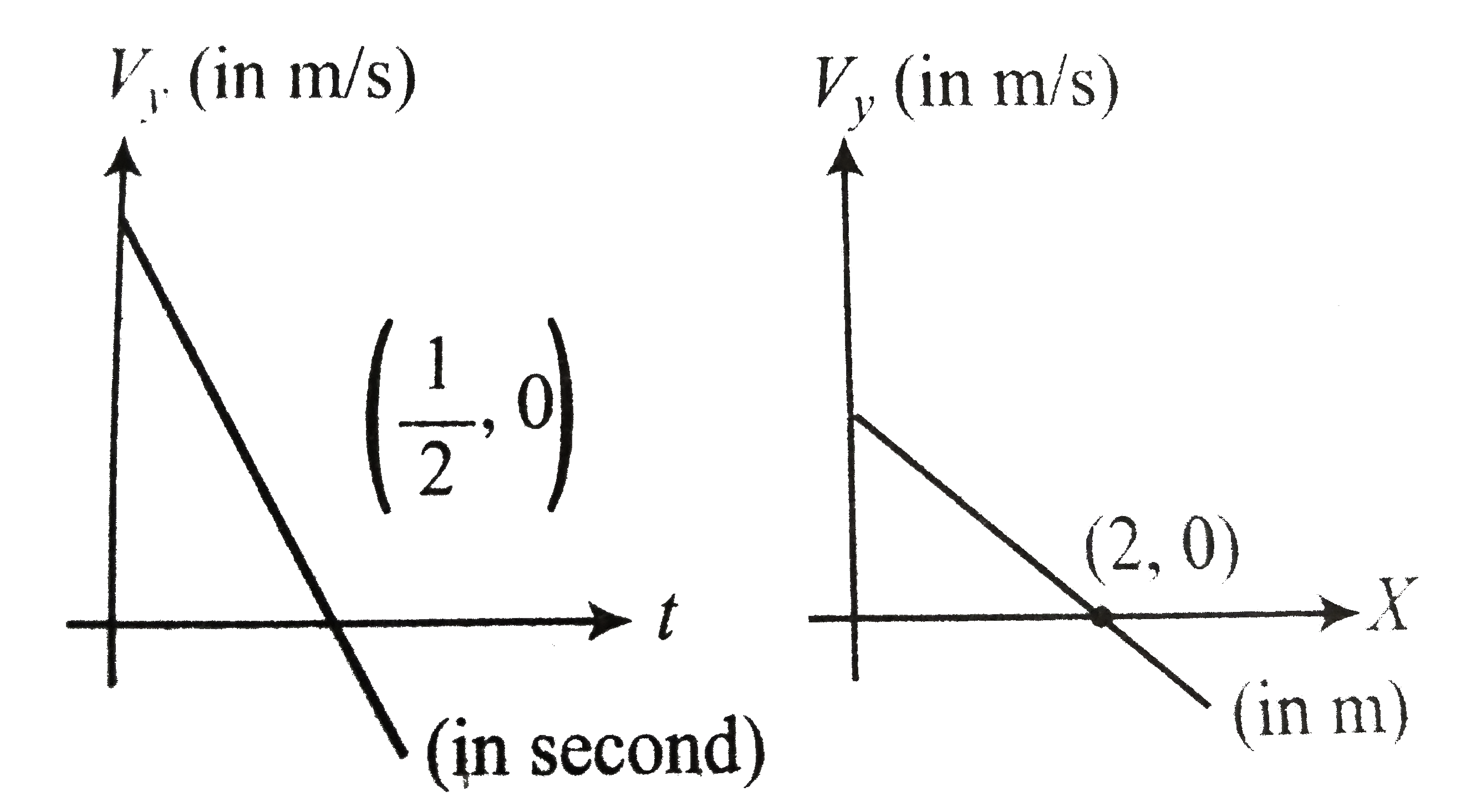At a height of 0.4 m from the ground, the velocity of projectile in vector from is →u=(6ˆi+2ˆj) (the x-axis is horizontal and y-axis is vertically upwards). The angle of projection is : (g=10m/s2)
45∘
60∘
30∘
tan−13/4
The correct Answer is:C
To find the angle of projection of the projectile given its initial velocity vector and height, we can follow these steps:
Step 1: Identify the components of the initial velocity vector
The initial velocity vector is given as:
→u=6^i+2^j
From this, we can identify:
- ux=6m/s (horizontal component)
- uy=2m/s (vertical component)
Step 2: Use the equation of motion to find the vertical component of the initial velocity
We know that the height s is 0.4 m, and the acceleration due to gravity g is 10 m/s² (acting downwards, hence negative). We can use the equation of motion:
v2y=u2y+2ays
Here, vy is the final vertical velocity, uy is the initial vertical velocity, ay=−g=−10m/s2, and s=0.4m.
Step 3: Substitute the known values into the equation
We need to find vy at the height of 0.4 m. We can rearrange the equation:
v2y=u2y+2(−10)(0.4)
Substituting the values:
v2y=u2y−8
Step 4: Calculate uy
From the initial velocity vector, we have uy=2m/s. Now, substituting this into the equation:
v2y=(2)2−8=4−8=−4
Since v2y cannot be negative, we need to find the correct vertical component of the initial velocity.
Step 5: Correctly calculate uy using the final velocity
We can find uy using the equation:
u2y=v2y+8
Assuming vy at the peak is 0 (for maximum height), we have:
u2y=0+8=8⟹uy=√8=2√2
Step 6: Calculate the angle of projection
Now that we have ux=6m/s and uy=2√2m/s, we can find the angle of projection θ using:
tanθ=uyux=2√26
tanθ=√23
Step 7: Find the angle using the inverse tangent function
To find θ:
θ=tan−1(√23)
Step 8: Determine the angle in degrees
Using a calculator, we can find:
θ≈30∘
Final Answer
The angle of projection is 30∘.
The initial velocity vector is given as:
→u=6^i+2^j
From this, we can identify:
- ux=6m/s (horizontal component)
- uy=2m/s (vertical component)
We know that the height s is 0.4 m, and the acceleration due to gravity g is 10 m/s² (acting downwards, hence negative). We can use the equation of motion:
v2y=u2y+2ays
Here, vy is the final vertical velocity, uy is the initial vertical velocity, ay=−g=−10m/s2, and s=0.4m.
We need to find vy at the height of 0.4 m. We can rearrange the equation:
v2y=u2y+2(−10)(0.4)
Substituting the values:
v2y=u2y−8
From the initial velocity vector, we have uy=2m/s. Now, substituting this into the equation:
v2y=(2)2−8=4−8=−4
Since v2y cannot be negative, we need to find the correct vertical component of the initial velocity.
We can find uy using the equation:
u2y=v2y+8
Assuming vy at the peak is 0 (for maximum height), we have:
u2y=0+8=8⟹uy=√8=2√2
Now that we have ux=6m/s and uy=2√2m/s, we can find the angle of projection θ using:
tanθ=uyux=2√26
tanθ=√23
To find θ:
θ=tan−1(√23)
Using a calculator, we can find:
θ≈30∘
The angle of projection is 30∘.
Topper's Solved these Questions
Similar Questions
Knowledge Check
A particle is projected from gound At a height of 0.4 m from the ground, the velocity of a projective in vector form is →v=(6ˆi+2ˆj)m/s (the x-axis is horizontal and y-axis is vertically upwards). The angle of projection is (g=10m/s2)
A45∘B60∘C30∘Dtan−1(3/4)At a height 0.4m from the ground the velocity of a projectile in vector form is →v=(6ˆi+2ˆj)ms−1. The angle of projection is
A45∘B60∘C30∘Dtan−1(3/4)Velocity of a projectile at height 15m from ground is v=(20ˆi+10ˆj)m/s. Here ˆi is in horizontal direction and ˆj is vertically upwards. Then
Angle of projectile with ground isA45∘B30∘C37∘D60∘
The angle made by the vecotr →A=ˆi+ˆj with x-axis is
View SolutionVelocity of a projectile at height 15m from ground is v=(20ˆi+10ˆj)m/s. Here ˆi is in horizontal direction and ˆj is vertically upwards. Then
Maximum height from a ground is ……..m
View SolutionTwo graphs of the same projectile motion (in the xy-plane) projected from origin are shown. X-axis is along horizontal direction and y-axis is vertically upwards. Take g=10ms−2.
 ,
,
The projection speed is :
View SolutionThe angel subtended by the vector A=6ˆi+3ˆj+4ˆk with the y-axis is
View SolutionTwo graphs of the same projectile motion (in the xy-plane) projected from origin are shown. X-axis is along horizontal direction and y-axis is vertically upwards. Take g=10ms−2.

Projection angle with the horizontal is :
View Solution

